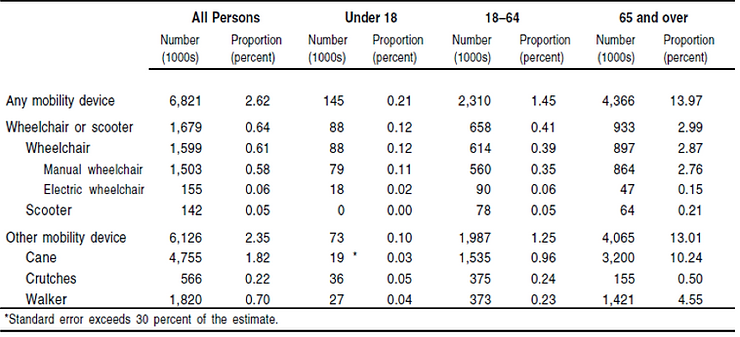When businesses are trying to determine the value of designing and marketing products/services for the disability sector, the first question they need to ask is, how many people with mobility related disabilities are there?
A 2000 report from the National Institute on Disability and Rehabilitation Research indicates that approximately 6.8 million individuals in the United States have disabilities that require the use of mobility assistance devices.[i] Among these people, 1.7 million of them use wheelchairs and scooters. About 6.1 million use both wheelchairs and other mobility devices simultaneously, such as canes, crutches, or walkers. The demographics of people using mobility devices by age and device are depicted in the table below.

The 76 million baby boomers who are now aging with mobility disabilities will propel the use of wheeled mobility devices even faster. Mitchell P. LaPlante of the Disability Statistics Center in California disclosed that the National Health Interview Survey on Disability of 2003 reported that 933,000 of the 1.7 million individuals using mobility devices are aged 65+. The 2010 data from the National Center for Health Statistics estimated that 7.4 million people in the United States use assisted devices for mobility.[ii] In the same year it was reported that there were an estimated 1.9 million amputees in the United States. On average, there are approximately 185,000 amputations surgeries performed each year. The numbers seem to increase significantly with the passage of time, and all of these individuals require either prosthetics or wheelchairs for mobility.
Europe is also experiencing an increase in the number of people requiring assistive mobility devices. Overall, the United Kingdom has over 10 million disabled adults aged 16+. These individuals constitute 24% of the entire population. There are around 1.2 million wheelchair users in the UK, and this is roughly 2% of UK population. In England alone there are 710,170 wheelchair users, and in the Netherlands there are 152,400 wheelchair users. The entire European Union has roughly 5 million wheelchair users, only about 28% of them all are under the age of 60. Statistics of assistive mobility device use in Europe in 2009 are reported in the table below.

In the United Kingdom, the number of individuals aged 65+ increased from 8.4 million in 1985 to 9 million by the year 2001.
- 2.1% of people aged 16-19 are disabled.
- 31% of people aged 50-75 are disabled.
- 78% of people aged 85+ are disabled.[iii]
Use of canes or walking sticks accounts for 24% of the disabled individuals aged under 75, and 39% among those aged 75+. Approximately 577,000 people in the UK receive benefits as a result of having problems with mobility. Roughly 5,000-6,000 major limb amputations are conducted in the UK every year, and these require the use of prosthetics for mobility after surgery.
According to the World Health Organization (WHO), more than a billion people in the world have one form of disability or another.[iv] Over 400 million of them live in Asia and the Pacific region. Approximately 200 million of them experience functional difficulties and need device assistance. About 70 million of them require wheelchairs for mobility, but not all of them have access to wheelchairs. Another 39 million need canes because of disability.[v] It’s not possible to have precise global data for all forms of disabilities since some countries have minimal functional infrastructure for collecting such data.

This data indicates that businesses need to recognize disability inclusion as the last frontier to bringing diversity and equality into their marketing and advertising efforts. The first step to demonstrating a commitment to this demographic is a welcoming website and associated media.
Many companies, such as Nordstrom, Honey Maid, and Guinness, have begun incorporating a disability inclusion strategy. Even Beyoncé now has a female model with a disability representing her clothing line.
Authentic stock imagery is now readily available to help businesses quickly adapt their websites and advertisements with positive representation of people with various disabilities. You can find imagery representing all ages participating in all aspects of social inclusion, from playing on playgrounds, dining out, buying a home, or taking a vacation.
PUSHLivingPhotos.com has demonstrated this concept exceptionally with their photo library. They represent the many willing, able, beautiful, strong, and positive examples of models with disabilities whose imagery could easily cross over to mainstream advertising. There should no longer be any question surrounding incorporating models with disabilities into magazine covers, marketing materials, websites, and online publications. They should be represented anywhere you see photos that illustrate what is good, wholesome, sexy, and human. PUSHLivingPhotos will even produce custom shoots for those who want to produce exclusive images for their product or service.
So, the next time you browse a website or read a magazine, ask yourself first, then ask the company: Where are the people with disabilities being represented?

Deborah enjoys a global network of contacts in the world of inclusive design and advocacy. She has the respect and influence to get initiatives seen, discussed, and implemented. She provides the insight, vision, and leadership to help companies discover how they can best meet the needs of the economically lucrative market of persons with disabilities.
Based in Fort Lauderdale, Davis earned a Bachelor’s of Business Administration in Finance from the University of Miami. Deborah has been honored as “Person of the Year” by the Magazine New Mobility in recognition of her leadership and innovation in the disability community. http://www.slideshare.net/srains/deborah-davis-as-new-mobility-person-of-the-year.
References:
[i] Kaye, H.S., Kang, T. & LaPlante, M.P. (2000). Mobility Device Use in the United States. National Institute on Disability and Rehabilitation Research. U.S. Department of Education. Accessed from http://dsc.ucsf.edu/pdf/report14.pdf
[ii] Strombeck, R. (2010). Demographic and Socioeconomic Factors Impacting the Future Assistive Technology Needs in Californians. Accessed from http://ilpconnect.org/wp-content/uploads/2013/01/FIRST-REPORT.pdf
[iii] Papworth Trust (2011). Disability in the United Kingdom. Accessed from http://www.papworth.org.uk/downloads/factsandfigures_disabilityintheuk_july2011_110721132605.pdf
[iv] Word Health Organization (2011). World Report on Disability. Accessed from http://whqlibdoc.who.int/publications/2011/9789240685215_eng.pdf
[v] McQuillan, M. (2013). White Cane Day 2013. Accessed from http://www.worldblindunion.org/English/news/Pages/White-Cane-Day-2013.aspx

